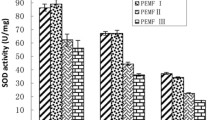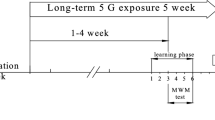Abstract
The aim of this study was to determine a possible relationship between whole-body 900-MHz Global System for Mobile Communication-like electromagnetic field (GSM-EMF) exposure and pathological changes in vital organs of Sprague–Dawley rats. Twenty adult male rats were used in four equal independent groups—control (without EMF) and low-, moderate-, and high-exposure groups—according to the time of exposure to EMF (1, 2, and 4 h). The exposure was performed for 30 consecutive days. Tissue samples of the heart, liver, and left kidney were collected and fixed in 10 % buffered formalin for histopathological examination. Some pathological lesions, especially in the kidney (congestion and inflammation) were seen. Our results demonstrate that the use of GSM-like EMF at these intensities and duration can induce pathological lesions in the heart, liver, or kidney, but these are not EMF specific.
Similar content being viewed by others
Avoid common mistakes on your manuscript.
Introduction
Mobile phones and their base stations transmit and receive signals using electromagnetic waves. Electromagnetic waves are emitted by many natural and man-made sources and play a very important role in our lives. Extensive epidemiological studies are commonly expected to provide the answer to whether electromagnetic field (EMF) exposure might be hazardous to people. However, findings and scientific validation of any potential health hazard, whether cancer or non-cancer effect, might be not possible using an epidemiological approach alone. Therefore, biological effects of EMF and their consequences on human health are receiving increasing scientific interest and have now become an urgent problem. It has been previously shown that Global System for Mobile Communication-like electromagnetic field (GSM-EMF) radiation can cause hematological, cardiac, endocrine, immunological, reproductive, and nervous system changes and also induce oxidative stress, cataracts, and behavioral changes in animal models (Lin 2003; Black and Heynick 2003; Koyu et al. 2005; Nittby et al. 2007; Kismali et al. 2009; Sarookhani et al. 2011; Jelodar et al. 2011; Khirazova et al. 2012; Jelodar et al. 2012). In humans, only the histological effects of using EMF radiation on the central nervous system and male genital organs were determined in a few studies (Albert et al. 1981; Tsurita et al. 2000; Salford et al. 2003).
To the best of our knowledge, there are only a few reports about the pathological changes associated with GSM-EMF radiation. Therefore, the aim of this study was to investigate whether the histological features of the heart, liver, and kidney of adult male Sprague–Dawley rats could be altered after exposure to the 900-MHz GSM-like EMF generator.
Materials and methods
Animal
Twenty male Sprague–Dawley rats, aged 12 weeks and weighing 170–190 g, were used as mature rats in this study. Animals were fed with water and standard laboratory diet available ad libitum. The study was approved by the Ethical Committee of the University of Shiraz.
Radio frequency wave generator
A signal generator for producing a 900-MHz signal was synthesized by the Department of Electronics from the Engineering College, Shiraz University, and the output was monitored by a spectrum analyzer (FSH6, made by Rohde and Schwarz, Germany) to ensure the correct forward power from the custom-designed mobile base stations for the animals exposed.
Experiment
Rats were divided randomly into four equal independent groups—5 of which were used as control (without EMF) and 15 of which, according to the time of exposure to EMF (1, 2, and 4 h), were divided into three subgroups (low, moderate, and high dose) with 5 per group. The exposures were performed for 30 consecutive days.
Histopathological evaluations
The animals were killed by cervical dislocation, and the heart, liver, and left kidney were immediately removed, free of surrounding fat, and fixed in 10 % buffered formalin for histopathologic examination. Formalin-fixed tissues were processed routinely and embedded in paraffin. Blocks were cut at 5 μm, and sections were stained with hematoxylin–eosin and studied microscopically.
Results
No toxic or behavioral changes were seen in any rats. Postmortem examination revealed focal lesions in the kidneys. Histopathologic examination of the hearts showed subendocardial hemorrhage in four rats, one rat from each group (Fig. 1). In the kidney, interstitial inflammation, hemorrhage, and congestion in the glomeruli and vessels were seen in all cases (Fig. 2). No significant histopathological lesions were observed in the liver. These pathological lesions were seen in all four experimental groups and were not EMF-specific changes.
Discussion
In the present study, pathological effects of a 900-MHz GSM-like EMF radiation emitted from a mobile phone simulator were evaluated by determining the existence of pathological lesions in the heart, liver, and kidney. Our results showed that some pathological lesions include inflammation, hemorrhage, and congestion, especially in the kidney among these three vital organs (Figs. 1 and 2). Investigations that evaluated the EMF radiation-related pathological changes are scarce and mainly focused on nervous system changes. Albert and his colleagues studied the effects of either 0.1 or 2.45 GHz, applied to young rats, on the histological appearance of cerebellar Purkinje cells. Exposure to both frequencies had similar effects, producing irreversible decreases of Purkinje cells in rats irradiated (Albert et al. 1981). Tsurita et al. (2000) investigated the effects of exposure to 1.439-GHz time division multiple access (TDMA) signals on Purkinje cells in the cerebellum of rats. No morphological changes were observed in any groups (Tsurita et al. 2000). The different results obtained by Albert et al. (1981) and Tsurita et al. (2000) might be due to the very different ages of the rats used. In another study conducted by Salford et al. (2003), nerve cell damage in the mammalian brain after exposure to microwaves from GSM mobile phones was evaluated. They found significant evidence for neuronal damage in the cortex, hippocampus, and basal ganglia in the brains of exposed rats (Salford et al. 2003). Our results are in agreement with the results of the previous research conducted by Forgács et al. (2006). They evaluated the effects of whole-body 1,800-MHz GSM-like microwave exposure on testicular steroidogenesis and histology in mice. In their study, the lack of any microwave-related histopathological alterations in the investigated organs including the testes, epididymes, adrenals, prostates, kidneys, hearts, liver, and pituitary was reported.
Further investigations are required to establish the biological and pathological significance of using the GSM-like EMF radiation. Also, other results must be focused on identifying the mechanism of possible effects of radiation.
References
Albert E, Sherif M, Papadopoulos N, Slaby F, Monahan J (1981) Effect of nonionizing radiation on the Purkinje cells of the rat cerebellum. Bioelectromagnetics 2:247–257
Black DR, Heynick LN (2003) Radiofrequency (RF) effects on blood cells, cardiac, endocrine, and immunological functions. Bioelectromagnetics 24:S187–S195
Forgács Z, Somosy Z, Kubinyi G, Bakos J, Hudák A, Surján A, Thuróczy G (2006) Effect of whole-body 1800 MHz GSM-like microwave exposure on testicular steroidogenesis and histology in mice. Reprod Toxicol 22:111–117
Jelodar G, Nazifi S, Nuhravesh M (2011) Effect of electromagnetic field generated by BTS on hematological parameters and cellular composition of bone marrow in rat. Comp Clin Pathol 20:551–555
Jelodar G, Talebzadeh MR, Ansari Lari M (2012) Effect of short-term exposure to radio frequency emitted by base transceiver station (BTS) antenna on epididymal sperms. Comp Clin Pathol 21:1285–1290
Khirazova E, Baizhumanov A, Trofimova L, Deev L, Maslova M, Sokolova N, Kudryashova NY (2012) Effects of GSM-frequency electromagnetic radiation on some physiological and biochemical parameters in rats. Bull Exp Biol Med 153:817–820
Kismali G, Ozgur E, Sayiner S, Alpaslan B, Guler G, Seyhan N, Sel T (2009) The effects of epigallocatechin gallate and N-acetylcysteine on mobile phone-induced oxidative stress in guinea pigs. J Anim Vet Adv 8:959–961
Koyu A, Cesur G, Ozguner F, Akdogan M, Mollaoglu H, Ozen S (2005) Effects of 900 MHz electromagnetic field on TSH and thyroid hormones in rats. Toxicol Lett 157:257–262
Lin JC (2003) Cataracts and cell-phone radiation. Antennas and Propagation Magazine, IEEE 45:171–174
Nittby H, Grafström G, Tian DP, Malmgren L, Brun A, Persson BR, Salford LG, Eberhardt J (2007) Cognitive impairment in rats after long-term exposure to GSM-900 mobile phone radiation. Bioelectromagnetics 29:219–232
Salford LG, Brun AE, Eberhardt JL, Malmgren L, Persson BR (2003) Nerve cell damage in mammalian brain after exposure to microwaves from GSM mobile phones. Environ Health Perspect 111:881
Sarookhani M, Rezaei MA, Safari A, Zaroushani V, Ziaeiha M (2011) The influence of 950 MHz magnetic field (mobile phone radiation) on sex organ and adrenal functions of male rabbits. Afr J Biochem Res 5:65–68
Tsurita G, Nagawa H, Ueno S, Watanabe S, Taki M (2000) Biological and morphological effects on the brain after exposure of rats to a 1439 MHz TDMA field. Bioelectromagnetics 21:364–371
Acknowledgment
Thanks are due to Dr. Mahjoob Vahedi and all the staff of the Laboratory Animal Center, Shiraz University of Medical Sciences, Shiraz, Iran for their help in providing and keeping the normal mature rats.
Conflict of interest
The authors declare that they have no conflict of interest.
Author information
Authors and Affiliations
Corresponding author
Rights and permissions
About this article
Cite this article
Sepehrimanesh, M., Azarpira, N., Saeb, M. et al. Pathological changes associated with experimental 900-MHz electromagnetic wave exposure in rats. Comp Clin Pathol 23, 1629–1631 (2014). https://doi.org/10.1007/s00580-013-1835-0
Received:
Accepted:
Published:
Issue Date:
DOI: https://doi.org/10.1007/s00580-013-1835-0






